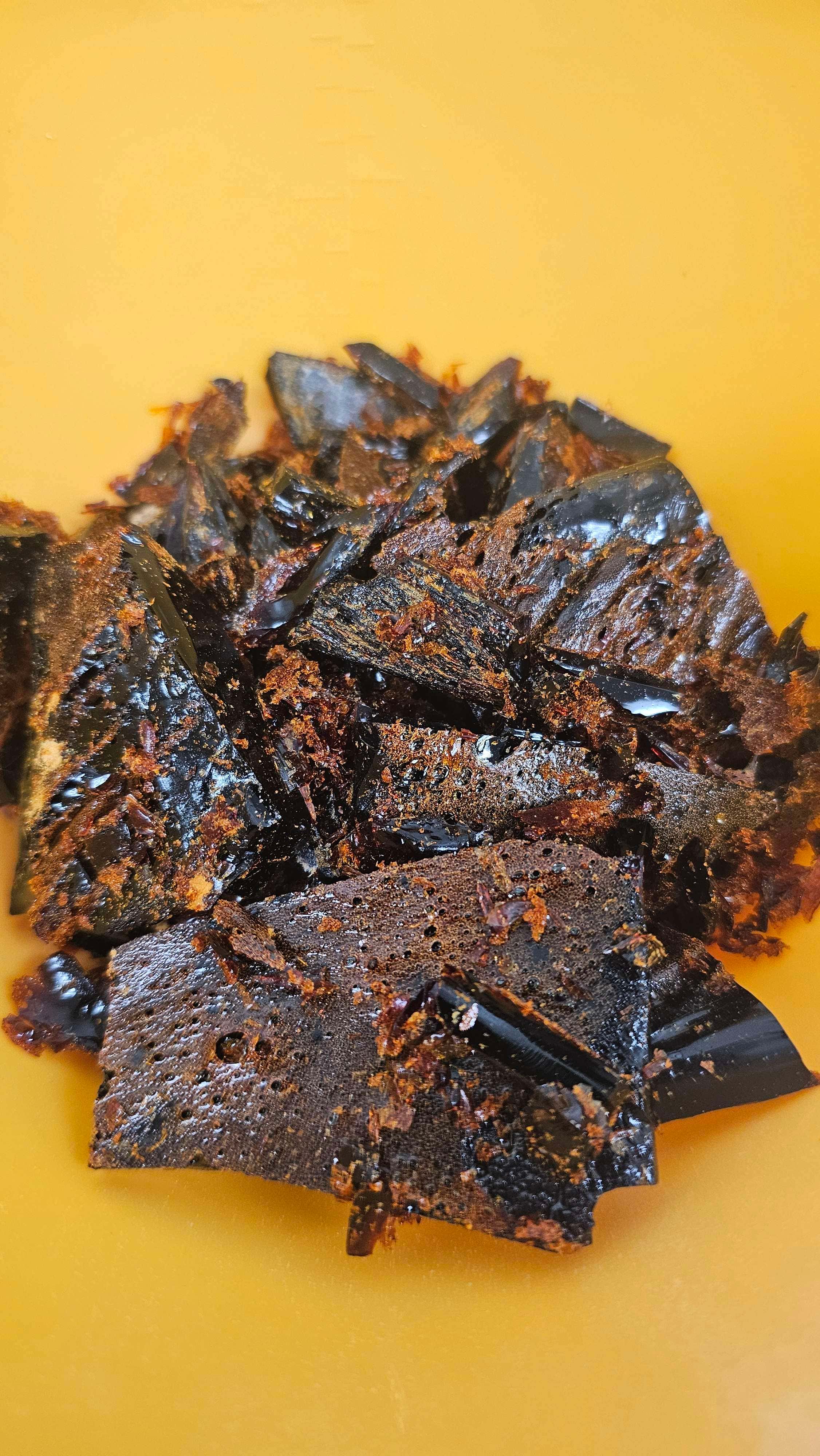Enhancing Your Belgian Beers: Making Candi Sugar at Home

What Exactly Is Candi Sugar, And How Does It Benefit My Beer?
The process of making candi sugar involves inverting, then caramelizing sugar syrups at high temperatures, which results in a range of colors and flavors. This caramelization process can produce a variety of sugars with different characteristics, allowing brewer to tailor the sugar to their specific beer recipes.
Simply put, inverting sugar is the process of breaking down complex sugars, such as sucrose, into simple sugars, such as fructose and glucose. These simple sugars are more efficient for the yeast to ferment since the yeast would normally have to create an enzyme (invertase) to break the sugar down itself, which is just more work for the yeast. This inversion will result in a much cleaner flavor profile than using sugar on its own.
Candi sugar is very easy to make from normal cane or beet sugar, which are both sources of sucrose. You will only need 1 other ingredient, and that is a food grade acid of some sort to invert the sugar. Citric acid will work, but “cream of tartar” (potassium bitartrate) is available in just about every grocery store so it may be more accessible to you.
The exact method of making real Belgian candi sugar is a closely guarded secret held by the manufacturers, but with the instructions below, you should be able to make something very similar at home, and for a fraction of the cost (it can be expensive stuff to obtain).

The History and Tradition of Candi Sugar
“Candi” sugar, also known as Belgian candi sugar, or candi syrup, has a long history in Belgian brewing and is integral to the production of many Belgian beer styles, particularly the stronger ones like Tripels, Dubbels, and Quadrupels. The spelling, “candi sugar” is a variation of “candied sugar”. This also differentiates it from other sugars that may be used in the candy making process. The spelling specifically denotes its association with Belgian brewing practices and traditions.
The use of candi sugar dates back centuries in Belgium, and it became particularly popular during the medieval period. Brewers initially used honey as a fermentable sugar source, but as trade routes expanded and other sources became more widely available, candi sugar became a more common ingredient in brewing.
Historically, cane sugar and honey were precious commodities in Europe and were quite expensive. Belgian brewers found that using adjunct sugars derived from a cheaper, but plentiful product like beets, could boost the alcohol content of their beers without adding excessive body or sweetness - and at a more affordable cost than using more expensive sugar sources. This was particularly important in regions like Belgium where beer was a staple part of the diet.
The addition of candi sugar serves several purposes in Belgian brewing:
- 1. Color Enhancement: Candi sugar comes in various forms, such as liquid, soft, and rock, and it also comes in various colors, including light, amber, and dark. Brewers use different types of candi sugar to achieve the desired color in their beer. The sugars undergo caramelization during production, contributing to the color of the final product
- 2. Flavor Enhancement: Candi sugar can impart unique flavors to the beer, depending on its type. Dark candi sugar may add caramel, toffee, or dark fruit notes, while light candi sugar may contribute a more subtle sweetness.
- 3. Alcohol Boost: Belgian beers are often characterized by higher alcohol content, and candi sugar is an efficient way to increase fermentable sugars without adding excessive body to the beer. The additional sugars boost the alcohol content without significantly increasing the maltiness.
- 4. Dryness: Some Belgian beer styles, such as Tripels and Strong Golden Ales, benefit from the addition of candi sugar to create a drier finish in the beer. This is because the sugars are highly fermentable and can be easily consumed by yeast.

Making Hard Candi Sugar:
SAFETY WARNING: Working with boiling hot sugar can be dangerous and can cause severe burns! It is advised to wear eye protection and heat resistant gloves when handling hot syrups. Adding cold water to hot syrup can result in splash-back so, as with all cooking, please be safe and use the proper protective gear.
I’m using 1 lb of sugar for this recipe, but feel free to adjust to your needs.
Ingredients:
- • Cane or beet sugar (both work equally well)
- • Cream of tartar (citric acid will also work)
- • Water
Tools:
- • Cooking Pot
- • Thermometer
- • Long Spoon
- • Baking sheet/tray lined with aluminum foil or, preferably parchment paper, which will peel off easier.
Process:
- 1. Add the sugar to your cooking pot and place over medium heat on your stove.
- 2. Add enough water to dissolve the sugar into a syrup, adding slowly and stirring as you go until it is all dissolved into a syrup. Don’t worry about the exact amount of water added as it will boil off during this process anyway. ½ cup of water to 1lb of sugar is the ratio I use. It will be thick, but once heated, it will eventually thin out as the sugar melts.
- 3. Once dissolved, you now have what is known as “simple syrup”. Now it’s time to add the acid. 1/8 tsp of cream of tartar per lb of sugar is an acceptable ratio.
- 4. Raise the boiling temp to just above 260° F, but do NOT let it go above 275° F. Hold this temperature for 20 minutes. During this time, the acid will invert the sucrose into glucose and fructose molecules. Water will slowly boil off during these 20 minutes, which will raise the temperature of the solution. To keep from going above 275° F, add a few tablespoons of water to lower the temperature. BE CAREFUL when doing this as the water can steam and cause splash-back.
- 5. After 20 minutes, you now have clear candi sugar. If this was your goal, you can skip to step 7. However, if you want a darker candi sugar, continue to the next step.
- 6. To make a darker candi sugar, simply keep boiling between 260° F and 275° F until you have achieved the desired color. The longer you boil, the darker it will get. Remember to keep adding teaspoons of water if the temperature gets too hot.
- 7. Raise the temperature to 300° F. In candy making, this is known as a “hard crack” temperature and will solidify the candi sugar into a “rock candy” when it cools.
- 8. Once at 300° F, carefully pour the syrup into the aluminum/parchment-lined baking sheet/tray and let it sit at room temperature until it hardens, which may take up to an hour or more.
- 9. Once hardened, you can break it into pieces and store it in an airtight container in a cool place for up to a year. Tip: Lightly coat the pieces in powdered sugar to prevent them from sticking together in storage.




Making Candi Syrup:
While the steps above will result in a hard candi sugar that can be stored for long periods of time, this form of the sugar can be difficult to dissolve into the wort, taking more time than you may want to spend. For this reason, I am also including instructions on how to preprocess your hard candi sugar ahead of time into an easy-to-use syrup that will dissolve into the wort much faster.
Process:
- 1. Add ½ lb of hard candi sugar to your pot and bring the heat on your stovetop to medium. Don’t add the entire 1 lb you made above, or it may become too messy and can possibly burn.
- 2. Add ¼ cup of water to the pot and begin stirring until it is fully dissolved. Do not raise the temperature to dissolve the sugar faster. This may cause it to burn. Patience is key here.
- 3. Once it is fully dissolved, you can add any remaining candi sugar and stir until it is also fully dissolved.
- 4. If the mixture is too thick, add a small amount of water until you’ve reached the desired consistency.
- 5. Store the candi syrup in glass jars. If using plastic jars, be sure to cool the syrup first.
Store in a dry, cool place, but do NOT refrigerate as this will result in the sugar crystallizing and hardening, making it difficult to use. Keep in mind that candi syrup doesn’t have the long shelf life hard candi sugar has. The syrup will only last for about 30 days before it loses quality via oxidation, and it is also more prone to mold. Commercial syrups can last much longer because they are typically sealed with nitrogen, protecting the sugar.
Using Candi Syrup in Mr. Beer refills/recipes:
Use 1 cup of syrup for every 2 gallon batch. Use more if you want a higher ABV and dry body. See below for some of our Belgian recipes and recommendations. Candi syrup will enhance any of these recipes. Cheers!










